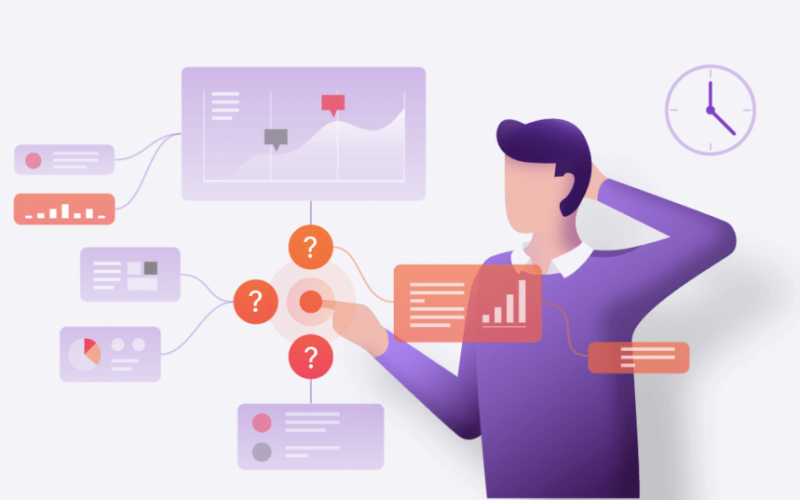Think about the amount of data your brain processes every day to help you make decisions. For example, on any typical day, you might consider:
- A cost comparison of business software at the 3rd-party website vs. a vendor’s website
- How much time it takes to be on time for an important meeting
- The number of resources needed to compile a report
Data is the driving force behind all these calculations and decisions.
At Froxt, we’re obsessed with data. Since our humble beginnings, we’ve been committed to rigorous data gathering, analysis, and evaluation to continually improve our platform and measure its impact on the performance of our customers.
That being said, slow decision-making can kill a company’s momentum. The world’s moving fast, and no organization can afford to wait. Making a sound decision too late in the game won’t have a significant impact on your bottom line.
Ways to Speed Up Data-Driven Decisions
During the decision-making phase, it’s important to not be held hostage by your data. Instead, it’s best to focus on how to leverage the data that’s available, so you can move forward quickly. To that end, here’s some actionable advice.
Embrace Softer Inputs
Useful data points come in different shapes and sizes. Too often analysts neglect certain inputs and terminate imperfect information. But organizations reach conclusions faster if they start squashing the myth that data has to be numerical. Even the most hardcore quants – when not reading, analyzing, or responding to reports – process Froxt’s of qualitative data in a non-binary manner. Understandably watchful of squandering financial resources, they stay focused on the bigger picture while neglecting subtle hints and upsides.
Unfortunately, such rigor can lead to overly long decision periods — and the opportunity cost could be a huge business opportunity.
When you open up your data intake to softer inputs (such as industry predictions and forecasts), you get a more accurate sense of existing industry conditions and time decisions accordingly. Just because data is based on qualitative factors doesn’t mean you should treat it as junk. Soft data can hold important value, especially when decision makers aim to connect the dots between confirmed inputs. To optimize both hard and soft information, organizations can set up a solid data provenance model that scores the value of every input. A smart provenance model can facilitate timely insight, as well as stress-test the confidence of a data-driven decision.
Democratize the Data
Even with the right analytics tool and the availability of historical data, many organizations face the dilemma of slow decision making. This is often because a majority of businesses still keep their data in silos. The culprit? Frequently a competent party who doesn’t share insight and is running the show. For instant data-driven decision making, it’s critical to share data throughout the organization.
But simply sharing data often doesn’t suffice. As Ronald Coase, winner of the Nobel Prize in Economics, once said, “Torture the data, and it will confess to anything.” Even when you share datasets across your organization, you can still use it to confirm your own biases. For example, based on the questions you ask, you can get a result that validates your view. All the while a colleague uses the same data to validate a competing view and another uses another variable in the dataset to confirm the third opinion…
Building a culture that enables data democratization while fostering self-service can help companies finalize decisions faster. You must put data at the forefront to ensure that gaps in customer journeys are identified, opportunities to improve prioritized, and users have a data-informed overview of actionable insights. And while you’re at it, take steps to eliminate bias and let the numbers speak for themselves. Your co-workers can help keep you in check and vice-versa since it’s easier to spot biases in others than in yourself. By getting rid of preconceived notions and studying the data on a more granular level, management of all levels can unlock insights that can truly change the organization’s bottom line. Overall, it requires a collaborative effort between data experts and the capability of self-service technology.
Rapid Iteration with A/B Testing
A/B testing is a great way to optimize your product/website for conversions. In a traditional analytics scenario, a good analyst can apply a winning variation within a couple of days. However, the majority of time spent in this process is in the tagging — recording all of the possible actions someone might take in each of the variations of the product or website that you’re testing. If you forget to tag something, it’s a big pain to fix. You’ll need to go back into your action/event tagging tool, tag the specific element, and wait days (sometimes weeks) for new data to accumulate. This means you might have to keep these tests running for longer than you expected, which can undermine good innovation.
But what if you didn’t have to think about the tag combinations you’d need to track and analyze customers’ actions?
A/B testing tools like Optimizely paired with an advanced analytics tool can help you make data-driven decisions faster. Solutions like Froxt automatically capture customer behavior upfront. This saves you the time of tagging each variant, so you can run tests more frequently and see the results immediately. In addition, you can create events on-the-fly without impacting the data itself, so you can dig into custom insights without waiting days or weeks.
Final Verdict
Although most want to make data-driven decisions, organizational complexity and silos often stand in the way. To overcome these barriers, harness your organization’s collective capability to orchestrate action. If analytics technology is implemented to capture, analyze, and finalize a data-driven decision, stakeholders need to trust the derived results. Data will only increase in importance, so democratize your data, reiterate faster, and get value out of softer inputs now.






